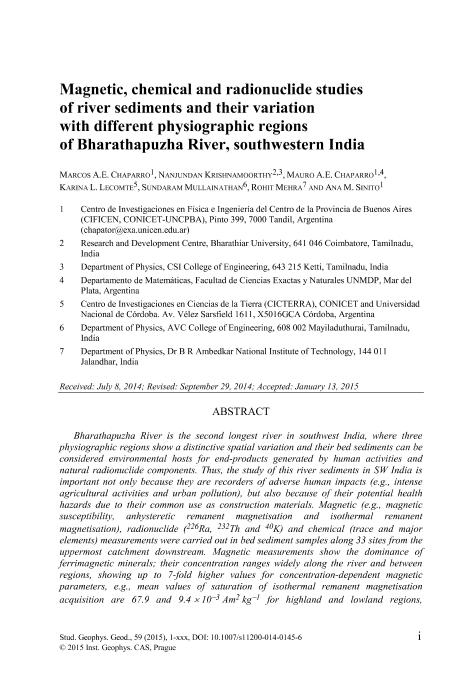Mostrar el registro sencillo del ítem
dc.contributor.author
Chaparro, Marcos Adrián Eduardo

dc.contributor.author
Krishnamoorthy, Nanjundan
dc.contributor.author
Chaparro, Mauro Alejandro Eduardo

dc.contributor.author
Lecomte, Karina Leticia

dc.contributor.author
Mullainathan, Sundaram
dc.contributor.author
Mehra, Rohit
dc.contributor.author
Sinito, Ana Maria

dc.date.available
2016-09-09T18:56:35Z
dc.date.issued
2015-03
dc.identifier.citation
Chaparro, Marcos Adrián Eduardo; Krishnamoorthy, Nanjundan; Chaparro, Mauro Alejandro Eduardo; Lecomte, Karina Leticia; Mullainathan, Sundaram; et al.; Magnetic studies of river sediments and its variation with different physiographic regions of Bharathapuzha River, southwestern India; Springer; Studia Geophysica Et Geodaetica; 59; 3; 3-2015; 438–460
dc.identifier.issn
0039-3169
dc.identifier.uri
http://hdl.handle.net/11336/7588
dc.description.abstract
Bharathapuzha River is the second longest river in southwest India, where three physiographic regions show a distinctive spatial variation and their bed sediments can be considered environmental hosts for end-products generated by human activities and natural radionuclide components. Thus, the study of this river sediments in SW India is important not only because they are recorders of adverse human impacts (e.g., intense agricultural activities and urban pollution), but also because of their potential health hazards due to their common use as construction materials. Magnetic (e.g., magnetic susceptibility, anhysteretic remanent magnetisation and isothermal remanent magnetisation), radionuclide (226Ra, 232Th and 40K) and chemical (trace and major elements) measurements were carried out in bed sediment samples along 33 sites from the uppermost catchment downstream. Magnetic measurements show the dominance of ferrimagnetic minerals; their concentration ranges widely along the river and between regions, showing up to 7-fold higher values for concentration-dependent magnetic parameters, e.g., mean values of saturation of isothermal remanent magnetisation acquisition are 67.9 and 9.4 × 10-3 Am2 kg-1 for highland and lowland regions, respectively. Multivariate statistical analyses show the existence of relationships between magnetic, radioactivity and chemical variables. In particular, magnetic concentrationdependent parameters are significantly correlated with radioactivity variables 40K and 226Ra (with concentrations about 20% higher than the worldwide mean values), as well as with some elements: Fe, Ca and P. Such analyses also show differences between physiographic regions where samples from the highland (and lowland) region are well grouped showing higher (lower) magnetic concentrations and lower (higher) coercivity minerals. The spatial variation of magnetic parameters along the river can be related to the influence of both natural sources and human activities, i.e. urbanisation and intense agricultural activities. In this sense, environmental magnetism data provide very useful tools to investigate adverse human activities occurring in the riverine environment.
dc.format
application/pdf
dc.language.iso
eng
dc.publisher
Springer

dc.rights
info:eu-repo/semantics/openAccess
dc.rights.uri
https://creativecommons.org/licenses/by-nc-sa/2.5/ar/
dc.subject
Magnetic Parameters
dc.subject
Major And Trace Elements
dc.subject
Multivariate Statisticals Studies
dc.subject.classification
Ciencias Medioambientales

dc.subject.classification
Ciencias de la Tierra y relacionadas con el Medio Ambiente

dc.subject.classification
CIENCIAS NATURALES Y EXACTAS

dc.title
Magnetic studies of river sediments and its variation with different physiographic regions of Bharathapuzha River, southwestern India
dc.type
info:eu-repo/semantics/article
dc.type
info:ar-repo/semantics/artículo
dc.type
info:eu-repo/semantics/publishedVersion
dc.date.updated
2016-03-04T17:42:51Z
dc.journal.volume
59
dc.journal.number
3
dc.journal.pagination
438–460
dc.journal.pais
Alemania

dc.journal.ciudad
Berlin
dc.description.fil
Fil: Chaparro, Marcos Adrián Eduardo. Consejo Nacional de Investigaciones Científicas y Técnicas. Centro Científico Tecnológico Tandil. Centro de Investigaciones En Física E Ingeniería del Centro de la Provincia de Buenos Aires; Argentina
dc.description.fil
Fil: Krishnamoorthy, Nanjundan. Bharathiar University; India. CSI College of Engineering; India
dc.description.fil
Fil: Chaparro, Mauro Alejandro Eduardo. Consejo Nacional de Investigaciones Científicas y Técnicas. Centro Científico Tecnológico Tandil. Centro de Investigaciones en Física e Ingeniería del Centro de la Provincia de Buenos Aires; Argentina. Universidad Nacional de Mar del Plata; Argentina
dc.description.fil
Fil: Lecomte, Karina Leticia. Consejo Nacional de Investigaciones Científicas y Técnicas. Centro Científico Tecnológico Córdoba. Centro de Investigaciones En Ciencias de la Tierra; Argentina
dc.description.fil
Fil: Mullainathan, Sundaram. AVC College of Engineering; India
dc.description.fil
Fil: Mehra, Rohit. Dr B. R. Ambedkar National Institute of Technology; India
dc.description.fil
Fil: Sinito, Ana Maria. Consejo Nacional de Investigaciones Científicas y Técnicas. Centro Científico Tecnológico Tandil. Centro de Investigaciones En Física E Ingeniería del Centro de la Provincia de Buenos Aires; Argentina
dc.journal.title
Studia Geophysica Et Geodaetica

dc.relation.alternativeid
info:eu-repo/semantics/altIdentifier/url/http://link.springer.com/article/10.1007/s11200-014-0145-6
dc.relation.alternativeid
info:eu-repo/semantics/altIdentifier/doi/http://dx.doi.org/10.1007/s11200-014-0145-6
Archivos asociados
